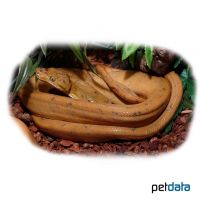Orange Garden Tree Boa (Corallus hortulanus)
| Orange Garden Tree Boa Corallus hortulanus | |
|---|---|
| Name | Orange Garden Tree Boa |
| Name Lat. | Corallus hortulanus |
| Synonym | Corallus enydris |
| Family | Boas |
| Family lat. | Boidae |
| Order | Scaled Reptiles |
| Order lat. | Squamata |
| Origin | N-South America |
| Habitat | Rainforest |
| Diet | Rodents |
| Humidity | 80-100 % |
| Behavior | Nocturnal, aggressive |
| Keeping | Individual, pair, group |
| Care Level | Experts only |
| Reproduction | Ovoviviparous |
| Housing | Humid terrarium |
| Life Span | 15-20 years |
| Protection | CITES Appendix II; EU Annex B |
| Metric Units | |
| Size | 150-220 cm |
| Temperature | 26-28 °C |
| Temperature Local | 30-35 °C |
| Housing Size | 150 x 80 x 200 cm |
| US Units | |
| Size | 59"-87" |
| Temperature | 79-82 °F |
| Temperature Local | 86-95 °F |
| Housing Size | 60" x 30" x 80" |
Distribution and habitat
The predominantly arboreal, crepuscular to nocturnal garden boas are widespread in southern Central America and northern South America. There they live on trees and bushes in the tropical lowland rainforest.
Maintenance
Minimum dimensions for the terrarium, according to the size and number of animals:
| 1-2 animals | 0,75KL x 0,5KL x 1,5KL (L x W x H) |
Body length (KL) is measured on the largest animal. For each additional animal the floor space should be increased by 20%. A terrarium of e.g. L 150 x W 80 x H 200 cm is recommended, which should be placed in a quiet and vibration-free place.
They need a terrarium structured with roots, horizontal climbing branches and cork tubes (hiding places, visual protection) with a loose, moisture retaining substrate, e.g. of peat-soil mixture with foliage and Sphagnum moss (no sand or gravel) as well as a large, easy to clean water basin as drinking and bathing possibility. Much of the substrate should be kept slightly moist at all times. Once a day, preferably in the evening, the inside of the terrarium should be finely sprayed with water (humidity), but a rain or mist system is better.
| Temp. day: 26-28 °C | Temp. night: 22-24 °C | Temp. local: up to 35 °C | Humidity: 80-100 |
Thermostatically controlled floor heating is recommended. Lighting duration must be 12-14 hrs. depending on the season. Daylight fluorescent tubes are ideal.
Diet
According to their size, they feed on mice, rats, guinea pigs and other rodents, as well as chicks and chickens. After acclimation, they often succeed in switching to commercially available frozen food animals. Juveniles should be offered food every 8-10 days and adults every 14-20 days, with occasional periods of fasting (e.g., skipping a feeding). If the snake is disturbed after feeding, this may result in vomiting of the prey. It is important to fortify the food animals with vitamins and minerals. Since the snake could be injured by live rodents, it should not be left unattended with them.
A varied diet promotes health and prevents deficiency symptoms.
Reproduction and breeding
Probing by the veterinarian is the only reliable method of sex determination. They are viviparous (ovoviviparous). The gestation period is 6-8 months, the fully developed 10-20 young are 40-55 cm long and can be fed young mice. The young of a litter can differ greatly in coloration and markings
Species protection
The animal population must be reported in writing to the responsible authority immediately after the beginning of the keeping. It is essential to find out about any bans on keeping or permits for keeping dangerous animals in your state or municipality (e.g. public order office)
Protection of species: WA Annex II; EU Annex B. The proof of purchase is the required proof of origin for the animal. Please keep it safe! Your pet store will be happy to provide you with further information.
Important
The species is often impetuous and can bite if disturbed. They occur with different markings and in different color varieties, from gray and brown to yellow, orange and red. If the air temperature in the terrarium is lower than the temperature in the water tank, there is a risk of respiratory infection. For the resting period, for 2-3 months, shorten the lighting period by 3-4 hours. When handling always have ready snake hooks, protective gloves and cold water
The terrarium must have good ventilation without drafts and meet the species specific needs. Measuring devices such as thermometers, hygrometers, etc. are necessary. The lighting has to correspond to the species-specific day-night rhythm and has to be placed in such a way that the animals cannot injure themselves. The terrarium should be locked in such a way that neither unauthorized persons can open it nor the animals can escape. Contamination must be removed regularly
Further literature can be found in your pet store.
References
Text: petdata; Image: petdata
Source: BMELV (1997): Tierschutzgutachten - Mindestanforderungen an die Haltung von Reptilien; ENGELMANN (2006): Zootierhaltung - Tiere in menschlicher Obhut: Reptilien und Amphibien, Harri Deutsch Verlag
- Gemäß § 21 Abs. 5 Tierschutzgesetz idgF
